Guild Update
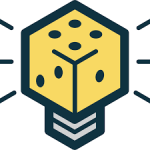
Guild Playtest Meetings
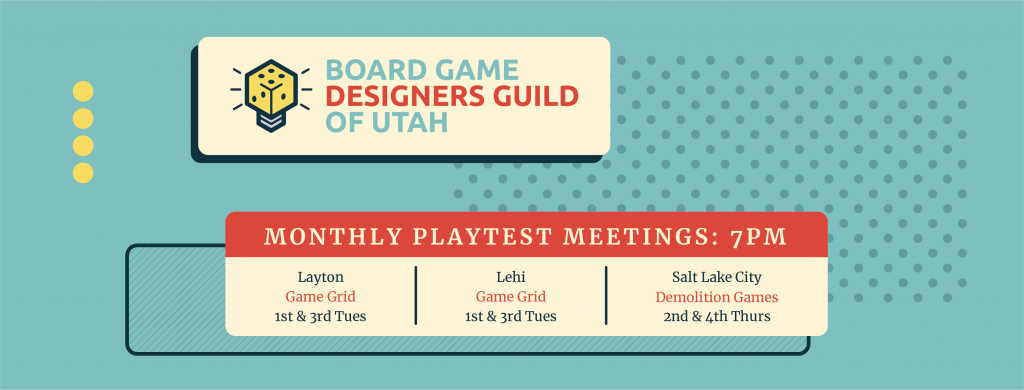
Discord and the Guild
The BGDG of Utah’s Discord is a great way to get to know those in the guild and discuss all things game design! If you’ve not joined yet, we’d love to have you come and participate with us!
BGDG of Utah Social Media
We have active Facebook, Twitter and Instagram accounts now! Please follow and start using #bgdgofutah in your game design related posts and they will be liked, retweeted etc!
Upcoming/Current Events
BGDG Business Meeting
We are currently planning to hold our Spring BGDG Business meeting either on May 11th at 9 am. More information will be posted in our Discord and Facebook. During business meetings we make general plans around future events, select individuals to fill roles within the guild and discuss other guild related subjects. We’d love anyone who’s interested in participating to attend, regardless of how long you’ve been in the guild!
ProtoCON Online
We will start planning ProtoCON Online, which will take place this Summer! This is a great opportunity to get one of your board/card game in a digital format (like Tabletopia or Tabletop Simulator) and playtest it at that event! Participants are not restricted to guild members. More information will be forthcoming!
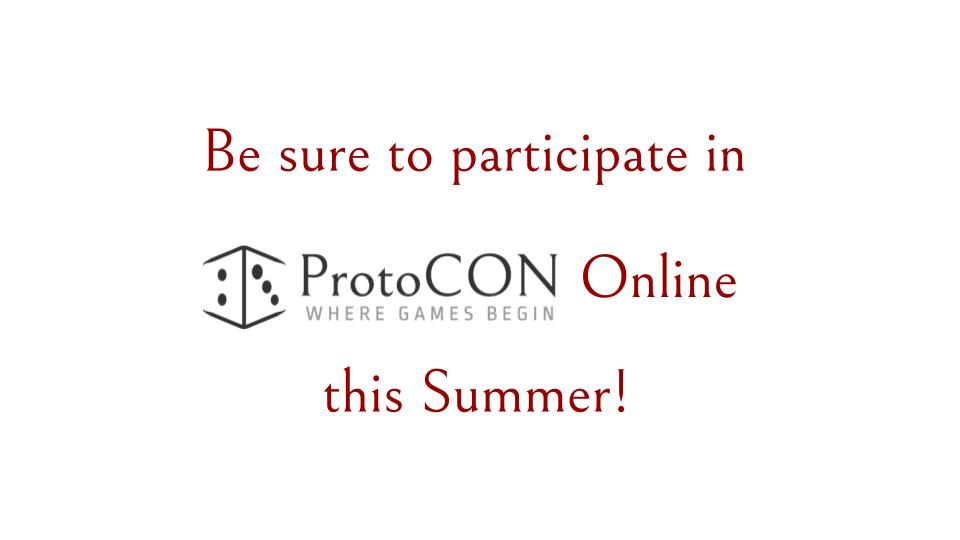
Current Design Contests
| Contest | Host | Deadline | Restrictions | Judges | Prizes | Contest Link |
| 2024 Children & Family Game Design Contest | BGG | 04/15/24 | Children and family games | BGG Community | Geek Gold | Contest Link |
| March-April 2024 Bi-Monthly 24 Hour Design Challenge | BGG | 04/30/24 | Cue word “three” | BGG Community | Geek Gold | Contest Link |
| 2024 Solomode Design Contest | BGG | 05/15/24 | Solo mode for an existing game | BGG Community | Geek Gold | Contest Link |
| That Cool Stock Part Challenge | The Game Crafter | 05/22/24 | Specific Components | Industry Panelists | Shop Credit | Contest Link |
| 2024 1 Card Print and Play Contest | BGG | 05/31/24 | 1 card and some bits | BGG Community | Geek Gold | Contest Link |
| 2024 War Game Print and Play Contest | BGG | 10/01/24 | War game | BGG Community | Geek Gold | Contest Link |
| LUCI Award | Playtest NW | TBD | None | Industry Panelists | None | Contest Link |
Contest information gathered from https://cardboardedison.com/contests
Exciting Local Game Design Highlights
Itamae San: the Sushi Game
Designed by William McCrery
Itamae San: the Sushi Game Kickstarter Link
Itamae San is a tabletop memory-style game for kids and grown ups! Featuring colorful, minimalistic illustrations, iconic shapes and patterns, and easy-to-learn gameplay, it’s perfect for both the sushi-enamored and sushi-dubious because just like sushi, it’s beautiful to look at; but unlike sushi, you’re not supposed to eat it.
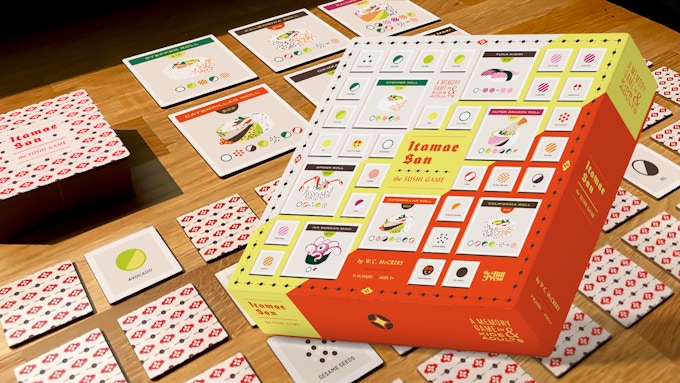
Assimilation
Designed by Brinler Tanner and published by Arclight Gamehouse
Assimilation is an asymmetric trick-taking/zone capture game in which you will be engaged in not one but four tricks simultaneously. And the single biggest troop doesn’t always win. Instead, you’ll be building up your troops’ power to capture war zones and assimilate enemy cards. You’ll battle rival commanders as you strive to outmaneuver whatever tactics come your way with your own clever strategies. The commander with the highest number of points at the end of the game wins.
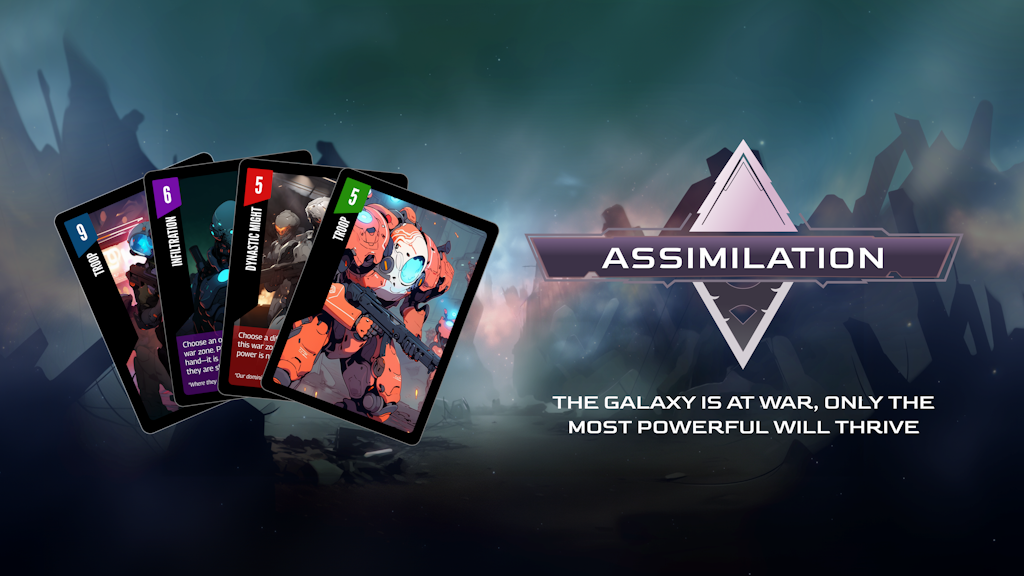
Bebop, Shuffle and Swing, and Cat Blues: The Big Gig
Published by Bitewing Games
Three games of cool jazz and cool cats.
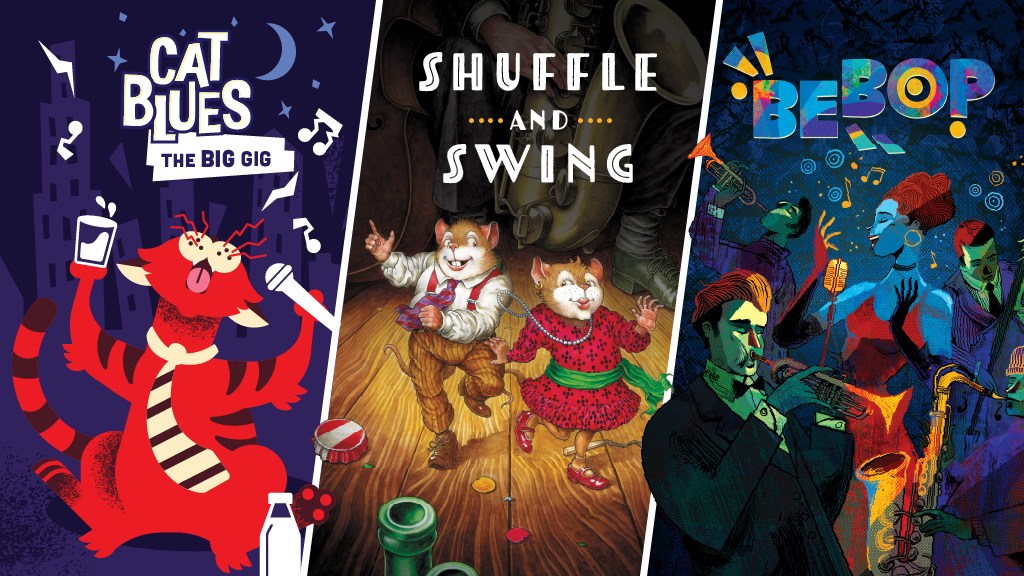
Interview with
William McCrery

Personal Questions
What’s your backstory? Tell us about yourself and how you got into game design.
I’ve always been interested in game design. I think I didn’t know that that’s what it was called for a long time. The first game I designed was in high school, that I clearly remember.
It was a Friday, or Saturday night and we were sitting around, as we tended to do as high school kids, and everybody was sort of, you know, debating, do we want to go see a movie, or go out to a restaurant to eat, or what do we want to do? And in the meantime, I started riffing on, like, we could do some Capture the Flag, but more extreme, and then the idea just got bigger and bigger. I lived in Sammamish, a town in Washington State which is known as the Sammamish Plateau, and there was this main road that runs through the entire town, kind of going north and south, essentially. And I thought, wouldn’t it be fun to play a game of Capture the Flag that just got so big that you actually had to use cars, and run through neighborhoods and climb fences and through forests. And it was sort of, I guess now that I think of it, LARPing without the fantasy aspect. It was very much Capture the Flag, but the idea was that it was on this gigantic scale. I called it Plateau-Wide Capture the Flag.
And I got so excited about it that I was like, “Jon, I need your computer.” So I went up and I used his computer and started a Word document that I emailed to myself. I don’t know, it was probably a Google Doc or something. And I just started, like, writing out all these ideas, and that’s what turned into the start of this game.
And that was the first game that I really remember designing deliberately, writing out the rules and creating the structure of it. There were, if I remember correctly, stipulations about crossing into private property—you couldn’t go into private property—walkie-talkies were okay to use, you of course had to obey the speed limit, and you couldn’t tag someone from a vehicle—you had to pursue them on foot—there were some rules around flag placement, things like that.
And, in fact—and I’ll try not to digress too much, but—I was hosting an unrelated high school competition, I think later that year, just a few months later, probably. And so I was the host, and the competition had concluded, but the judging was ongoing. And for some reason, it was taking a long time for the judges to decide on the winner. So myself and my co-host, we had to figure out how to fill the time. So I went out on stage and I talked to this auditorium of, you know, the entire student body and their parents and families and I just started to explain to them Plateau-Wide Capture the Flag. And afterwards people told me I had really sold them on this idea. So the following week I brought sign-up sheets to school, and I just got the entire school to sign up. I don’t remember how many sign-ups actually followed through and played it, but we did get a good amount.
And, yeah, anyway, the thing that I enjoyed the most, and that I looked back on and thought, gosh, that was fun, was just working through how to construct this game in a way that would be exciting to play. And then it was fun to see that other people thought so too, and I think that was the moment where I started to recognize that there was something here that I liked to do. It wasn’t just a way to kill time on a Saturday night in my friend’s attic when everybody else was trying to figure out what to go do.
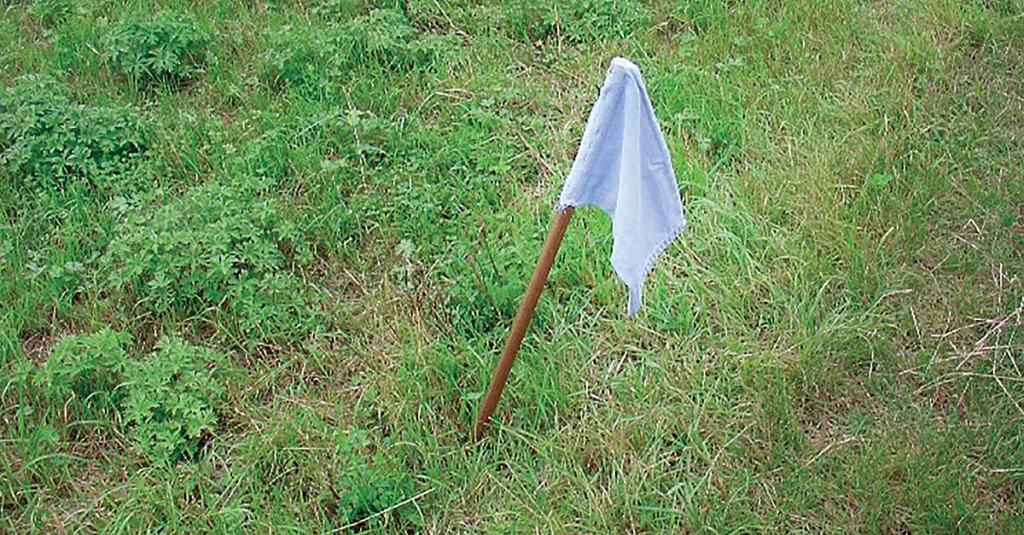
Can you walk us through your design process?
My design process is kind of a mix of brainstorming and jotting down ideas at first. I may free-write or type out kind of how I expect a game to operate and I’ll be capturing ideas as I go.
Things will occur to me in that kind of format. I almost let my imagination run, and kind of follow along beside it, trying to write down what’s working and what’s not, what ideas are worth circling back to. The nice thing about an imagination is you can pause it, turn it, zoom in and out, etc…
I try not to start by physically manipulating things and seeing how they work, I’ll get to that later. Once I feel like I’ve got a pretty good idea of what the game might consist of, then I will create a prototype of whatever’s needed to try out the game. Since I come from a graphic design background, I can sometimes head a little too quickly into designing components and game pieces and I sort of have to restrain myself from getting too invested in like, “Oh, this card is going to look great this way,” and “this is where I’m going to put the information and this is the kind of illustration I’m going to use.” Or I can get really nerdy about the production design of components. You know, I’ve got dials I want them to spin a certain way, and I can picture how we’re going to do cut-away pieces, and this is how we’ll produce it.
And those are kind of like traps that I can fall into, if I don’t restrain myself a little bit. But I also think it’s valuable to let myself go at times—sometimes you got to follow the muse where it leads—but then I sort of set those things aside, and I often come back and find that they’re useful at some point.
But initially I think I have to make sure I keep things loose. It’s a balance. I may try a version as lo-fi as I can get it, but then have to up the fidelity a little in order to represent the theme, to maybe preserve the kind of vibe I’m going for, if you will. I want to make sure that when somebody’s playing it that they don’t have just nothing to go on. I think that also misrepresents the game itself.
If I’m, for instance, creating a game that’s about getting to a train on time, I want to make sure that I’m not just writing down the mechanics on pieces of paper and seeing if the mechanics work. I want to make sure that people can also somewhat imagine the trains and imagine the kind of world that this game takes place in because that’s important to me.
Do you start with specific themes in mind or want to utilize certain mechanisms?
I definitely love a theme. I’m a sucker for a theme. I find that when I’m playing a board game, especially like a complex board game, something with strategy and any kind of backstory, I find myself tying my decisions to the story I’m telling in my head. And I oftentimes will almost derail the game for a few minutes while I explain to everyone else how the moves that I’m making, or the moves that other people are making tie back into the theme of the game.
So I’m I definitely am a sucker for a theme. And I love to start with a theme and then sort of deconstruct that reality into sort of mechanics that are understandable and can sort of recreate reality via those mechanics.
I’m not too heavily invested in strategy to begin with. I think winning is definitely a motivation—I have a hard time getting into purely story-based games that really don’t revolve around a kind of a win condition—but I’m not a super competitive person at heart. So I lean towards games that tell a story, and you compete within that world of that story.
I can get a little distracted by mechanics at times, I think. When I come across a mechanic that I love, I can sometimes try to incorporate that to the detriment of the overall game. In those moments I usually return to the theme as a kind of, you know, sanity check, but even then a mechanic can serve a theme perfectly, and still not benefit the overall game.
For instance, I like the variable nature of games like Settlers of Catan. That was my first introduction to a game board that changes each time you play the game. I just thought that was really interesting when I first experienced that. So I loved the idea of a game board for a sushi restaurant that represented a conveyor belt. And then I got to thinking about that sort of aspect of randomness coupled with strategy, where you roll some dice which are random, but there’s also a probability associated with what you’re going to roll. And I loved the idea of being able to slowly maneuver yourself into position to benefit from rolling a seven or a six or a five or something. And so I really got invested in this conveyor belt idea, and I built a working model—and, I still love it, I think it will be used in the future—but it turns out that I had to be willing to let that go to get to the current version of Itame-san.
How did you come to be involved with the guild?
I came across the guild when I was at a playtest meeting. I first was looking for a community where I could try out some game ideas that I was working on and also help support other people who were working on their own game ideas. And so through that, I came to a few playtest meetings at various game shops in Pleasant Grove and I think I went up north to a few as well. And then somebody put me onto the guild Facebook group and I signed up, and the rest is history.
If you could pick 3 games that every designer should have to play, as a sort of game design curriculum, what would you choose?
Three games every designer should have to play. That is a tough one.
Maybe I’ll start with three games that I love, that I think represent a wide variety of approaches to designing games.
The first is Captain Sonar. It is just such a unique experience. It is cooperative and competitive in a very non-contrived sort of way. I think that the mechanics of each role are just so beautifully simplified, and yet crucial at the same time. You’ve got to play it with six or eight people to really get the full effect. So that’s definitely one, although, I might end with it because it’s so unique, it’s a great example of pushing the boundaries of where tabletop games can go.
I think Splendor is a great example of an engine-building game that’s simple to learn. We pick it up and play it often at our house with my kids, even as young as when they were eight, and they liked it. I think it demonstrates how to keep players neck-and-neck, even while your tactics may be changing over the course of the game. At least that’s my experience with it.
A lot of these things I feel like I could go to Board Game Geek or reddit and find out that people disagree. But in my experience, Splendor is a great kind of simple introduction to an engine-building game.
And I think for the third game—it’s hard to narrow it down to three—but right now, and I reserve the right to change this answer later, I think I would say maybe Mafia or some kind of social deduction game like that.
I like how Mafia—and I’m talking about the kind of free-form party game version that’s different depending on who teaches it to you—introduces two things. First, the social deduction aspect with deception and playacting, which is fun. Second, the Moderator role: I think one of the fun things about playing Mafia with everybody sitting around in your living room is whoever in your group is a good storyteller, they get to run with it. And you have a sort of introduction to what a Dungeon Master is.
I’d probably then introduce Secret Hitler just to highlight how to maintain the social deduction aspect while removing the need for a moderator. Personally, and this is kind of a hot take maybe, I think Secret Hitler is just a little too tasteless for me—I think it’s unnecessarily tasteless to adopt the theme that it has—but it’s beautifully designed. And the mechanics are pretty well balanced, I think. But I would always want to bust out Secret Hitler and say, “and look at how beautifully designed this artwork is and these components. Look at this little Chancellor woodblock thing here,” you know? “You can do this, too, and make your game beautiful.”
So that’s what I would say are the three. And I would change those next week. but not Captain Sonar, I would always say Captain Sonar is just a perfect example of something that takes complexity and simplifies it, and is totally different, and works.
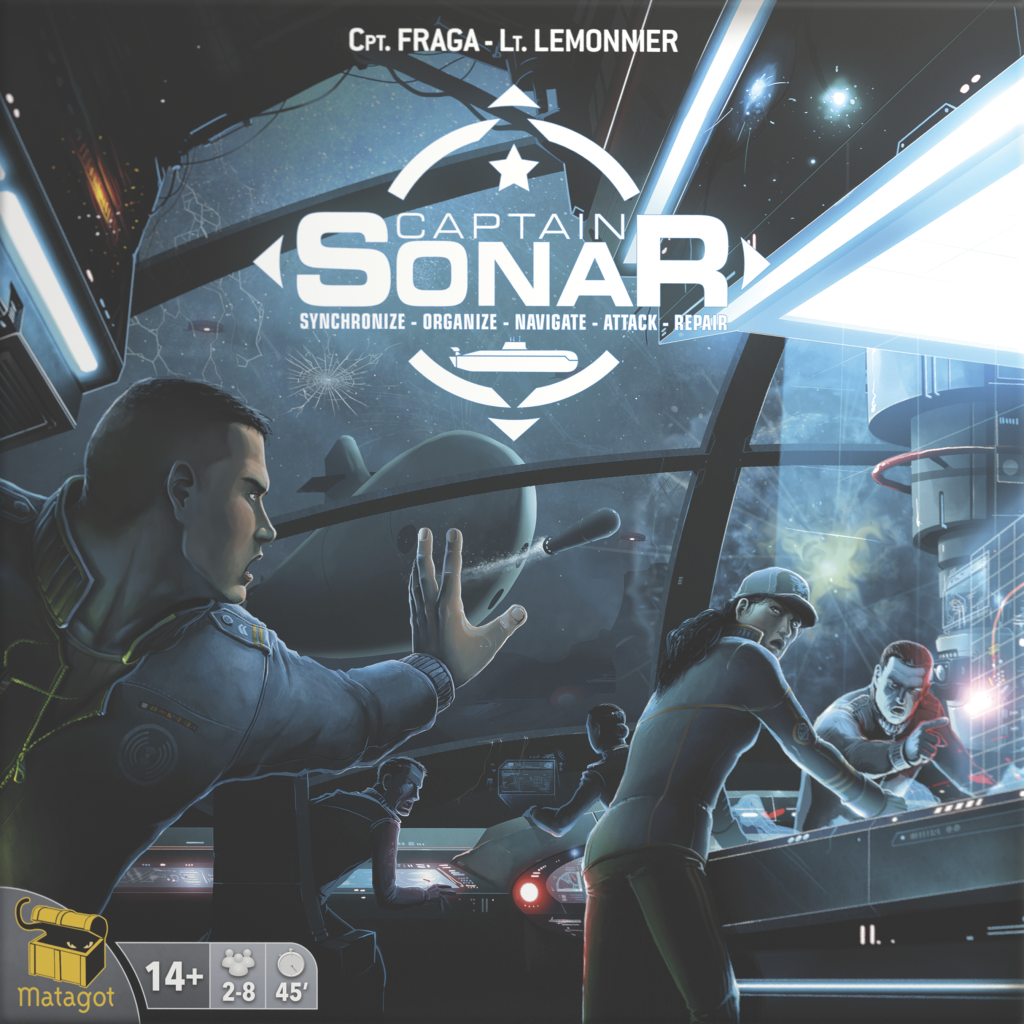

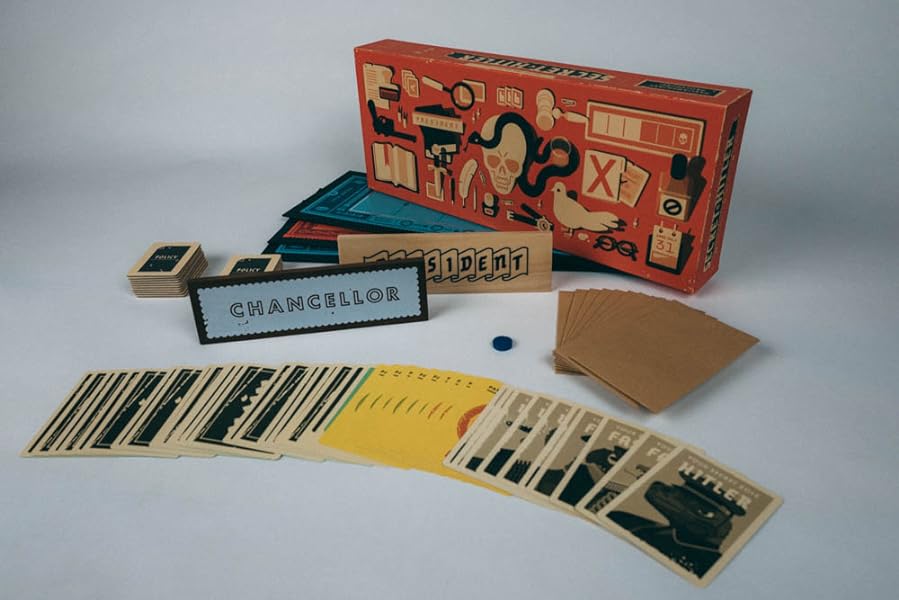
Game Design Related Questions
You have been working on a game called Itamae San: the Sushi Game? Could you tell us more about that?
Yeah! Itamae San: the Sushi Game. It’s a memory-style game about sushi (obviously). You play as a sushi chef and what you’re trying to do is create sushi orders and make money. And the way you do it is kind of an evolution of the classic memory game.
So in a classic memory game you’ve got a grid of tiles, and you flip two over, and if they are the same then you get that pair, and whoever has the most pairs at the end of the game wins—I’m not telling you anything you don’t know.
But in Itamae San, you have a grid of tiles face down, and these are all ingredients. And you also have Sushi Order tiles, and you shuffle up the Sushi Order tiles, you make a stack, and then you turn over six. And instead of trying to flip over ingredients that match each other, you’re actually trying to flip over just the ingredients that you see on any of the face-up Sushi Orders.
And then if you do that, you get to keep the Sushi Order, and you get the money. And whoever has earned the most money at the end of the game wins. So it isn’t necessarily about getting the most sushi orders. You can also win by getting just enough of the big sushi orders that are worth a lot of money. So there’s a good balance for kids and grown-ups in that sense, which makes the game especially great for families.
And that’s Itamae San. It’s pretty fun, pretty simple, but also unique. There isn’t another memory game like it. I think people tend not to riff on memory games beyond changing out the artwork, at least I have not encountered variations on the memory mechanic. It maybe seems like too simple a concept? Like what is there to change?
But I really think there’s something new here. Not an improvement, I don’t think that any change needs to be made to classic memory. But this game takes that mechanic and evolves it in a way that’s fun and unexpected.

What design challenges did you have to face when designing Itamae San?
Well, I think the biggest challenge I faced was scaling the game down. I spent a long, long time developing a concept around a sushi restaurant where you were the chef, and you were competing with other chefs, and it involved a rotating conveyor belt; it involved a fish market where you would auction off ingredients.
And there were some really fun moments, really fun mechanics in that concept, that I just really wanted to work, and I tried to whittle off some of the things that were kind of bloating the concept, but it never changed much from this kind of large-scale strategy game with multiple currencies. And so I even though I chipped away at it for years, it never felt quite like I was nearing completion.
And I was writing up something about, you know, creative projects that I’m always working on, and I was going to talk about Itamae San. And so I was describing this game, and I went back to its origins to describe where it had come from, and I discovered that my original concept had this potential I hadn’t recognized at the time. And I thought, what if instead of a sort of Ticket To Ride style game where each player is trying to complete their own sushi orders, what if anybody could get the sushi order, and all they had to do is remember where the ingredients were? And actually getting to that point came pretty quick.
It was the diverging on the concept, and going so big, that really proved challenging to overcome.
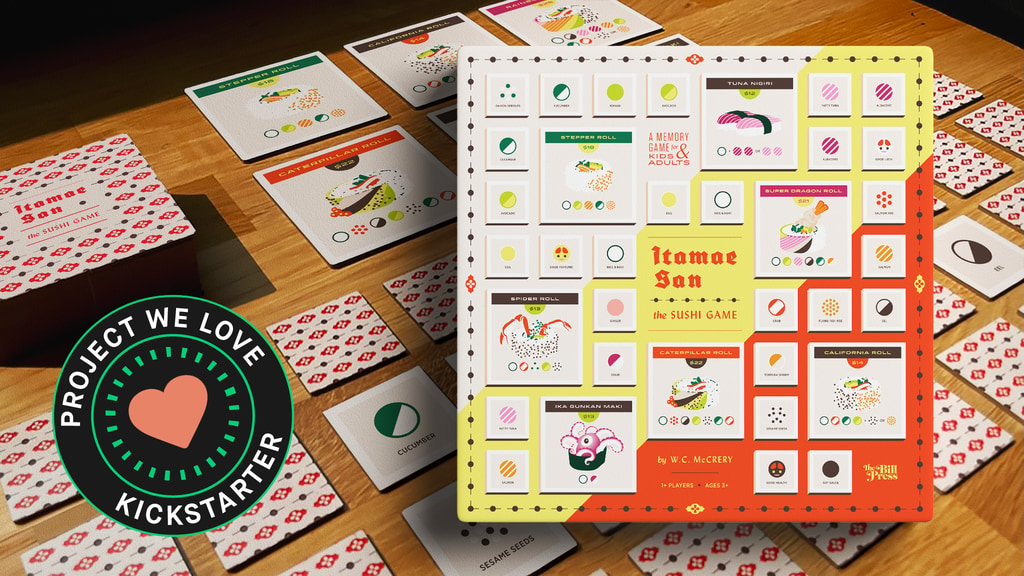
Do you have any advice for others when it comes to designing a game?
Advice to game designers is one thing that I feel like I am not qualified to give! This is pretty new for me, and I’m confident in what I’m creating but I’m also learning a lot and I’m surprised every day. So, my advice would not be about how to do this correctly, it would just be to… believe in yourself!
I think it’s worth it if it’s something you love. I have drawn on every skilled I have acquired in my career.
Tell us about some of the other designs you’ve been thinking about/working on.
Well, as far as what I am working on aside from Itamae San: the sushi game, I’m actually most excited about a sequel to the game that really builds on some of those concepts I mentioned that I had to let go of in order to get here.
But I think there’s a direction there that I hadn’t considered before, and I’m building around a restaurant theme that focuses on the relationship between customer and employee. I think that that’s a compelling dynamic.
In a lot of games you play one side of that relationship between the customer and the employee, and there is a sort of proxy for the other that’s a mechanic in the game. So you might have a game like Feudum where the Guilds that you’re interacting with are represented on the board, and there’re a handful of mechanics that kind of allow you to work with them, but a player doesn’t represent them.
I’m interested in this idea of almost two games happening at once, in a kind of symbiotic relationship between the two, where instead of competing with each other, they’re actually in the service of each other. So, for instance, you have sushi chefs who are trying to out-sell each other and make the most money, and on the other side you have these customers where money is no object, but they’re really interested in eating things that are going to impress their date without making them sick. And so I think there could be an interesting tension there that I’m really excited about seeing if I can crack.
And if anyone has examples of games like that, I would love to hear about them, because I haven’t encountered any yet.
Your game will be ending its campaign on Kickstarter soon. Tell us about your experience in crowdfunding a game.
Crowdfunding has been a fun, educational experience. I hadn’t done it before, I’d only backed many campaigns.
There’s definitely a rush at the beginning, lots of backers and just lots of support, and it’s been great. We have a few weeks to go, and we’re working on kind of amping up the campaign for that final week and a half push.
It’s something that I would do again. I’ve learned a lot, but I also feel like there’s things that I haven’t totally mastered. But what I told myself at the beginning of this was, I want to see how far I can go, essentially on my own power, in the sense that I’m not sharing revenue or profits with a third party (beyond Kickstarter’s percentage). I’m contracting with and working with manufacturers and distributors, obviously, as part of the process, but I want to see how far I can go just owning the whole thing myself.
And I think after this, I’ll be able to look back and say, hey, here’s some areas where, you know, with a partner who’s great at sales, I could see how much more reach I get. I think that’s something I’m excited to try. But this time, I wanted to just see what I could do. And it’s been great and empowering to go that route.
It’s been awesome to see the support that’s come from so many places I didn’t expect, and really encouraging.
Final Wrap up Questions
How would you suppose the guild could improve to better assist in the game development process?
Yeah the board game design guild has been really helpful. I didn’t know where to start, and it was great to have a community that was kind of in a similar place as I was, but also people that were beyond where I was, that I could look to and say, “Hey, how did you get there?”
And I mean, obviously for me it’s great to be able to talk about what I’m working on, but also as a creator to be able to hear from people who are working, and how they’re working can help get you over some hurdles when you’re stuck.
If people wanted to contact you or follow your game designs how should they go about that?
Well, there’s a few easy ways. We have a website: thebillpress.com, you can go to and that has links all over it to check out the Kickstarter campaign.
The other very easy thing you can do is go to Kickstarter and search for “Sushi”. Ours is actually the only active project that has anything to do with sushi right now, tabletop game, or otherwise. So if you just search for Sushi, you should see Itamae San: the Sushi Game, come up. And of course I would love the support!
~Bill McCrery
